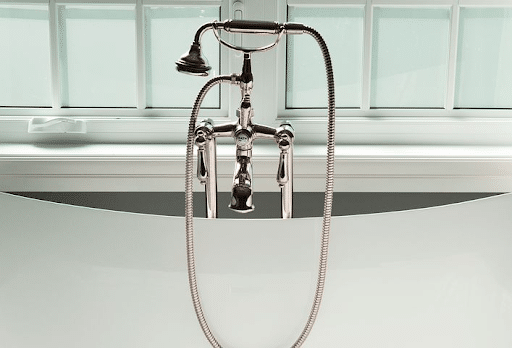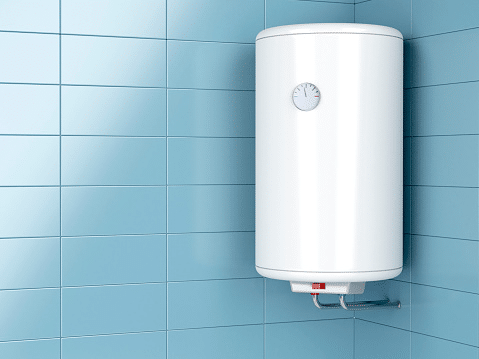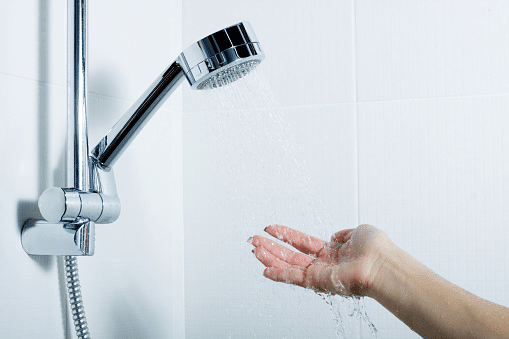
You can move on to the following potential scenarios now that you’ve established that the water heater is not the problem. If the shower head is the only source that doesn’t have hot water, your shower is probably having one of two problems:

When attempting to identify the cause of your shower not heating up, you may not need to search very far. The bathroom itself may be having problems.
The anti-scald valve prevents the water from becoming either too hot or too cold, which is a helpful feature. Though if your house is a little older, it might not have it. It’s typically incorporated into the shower handle.
First, the anti-scald valve might not have been fitted properly. The top and bottom segments of the anti-scald valve are sometimes not plainly marked. The valve might be in the incorrect location as a result of that.
If you want the proper amount of hot water to come out for you to have a hot shower, you probably need to remove the anti-scald valve from its present position and set it up properly.
Clogging could also be an issue with anti-scald valves. In other words, if you use these components frequently, they are likely to become blocked.
You must use water to flush the obstruction out of your clogged anti-scald valve in order to fix it. If that doesn’t work, and it still appears to be in poor condition, the valve might need to be replaced.
Improper calibration of the anti-scald valve is another potential cause of the issue. Maybe it’s set at a level that’s a little too high. To get your water at the proper temperature, you’ll need to modify it, especially when you’re having a shower temperature issue.
The spigot must now be turned to the right, and then the water must be tested. Test the heated water to see how it feels and if you like it. The opening should be adjusted repeatedly until the desired temperature is achieved. Most modern shower valve mixers can be difficult to set.
It can be difficult to work with pipelines. You may believe you have everything in the right places, only to discover after the fact that some parts have been inadvertently switched around.
One of those parts that can lapse into oblivion occasionally is the mixture valve. The mixing spigot is not easily accessible. Usually, it is best to leave this type of work to the experts.
If your mixing valve isn’t functioning properly, you might not be receiving enough hot water from your shower. You will need to replace the rubber components located in the mixing valves, as they gradually become worn out.
In addition to getting older, the rubber parts deteriorate because of constant exposure to hot temperatures. These rubber fragments may move and create blockages in the shower pipes as soon as they begin to crack.
In order for you to take a comfortable shower, the mixing valve must be set so that the proper quantity of cold water is blended in with the hot water.
But there’s a problem: some mixing valves might let too much cold water mix with the hot water. As a consequence, a plumbing crossover phenomenon occurs.
There is a good possibility that you won’t have the hot water you require for your showers if a plumbing crossover is occurring along your shower pipes. The water’s temperature can best be described as tepid.
The cost of hiring a master plumber who is properly qualified and licensed can be high. Unfortunately, the majority of homeowners lack the knowledge and equipment necessary to repair a shower mixing valve or any other functional component of a shower or water heater.
A bathroom mixing valve replacement typically costs between $230 and $600 nationally.
Both the labor and the valve assembly unit are included in the price. The cost ranges from $100 to $350 if only the battery needs to be changed. The price increases if the complete shower valve needs to be replaced. An entirely new bathroom valve costs, on average, $550.
You and the contractors you engaged may discover that your shower is in perfect working order after performing a thorough inspection of all of its various parts.
Then why is there no hot water in that situation? The layout of your home’s pipelines may have something to do with the problem.
Cross-connected pipelines may be to blame for the cold water you’re experiencing.
In the past, pipelines that were cross-connected were helpful. Back then, house builders had to come up with alternative methods for allowing the flow of hot and cold water into showers, because parts like mixing valves weren’t yet available. They installed cross-connected pipes as a solution.
Those cross-connected pipes were essential in the past, but modern innovations that have made hot water more accessible have made them obsolete. However, those cross-connected lines could still exist, and they could be the source of your current issues.
Cross-connected pipes aren’t necessarily the issue, though it’s difficult to tell. To determine that they are the main reason for your lukewarm showers, you’ll frequently need to use the method of exclusion.
Despite not posing a threat to your water supply, corroded pipes are still an issue. The fact that they can considerably lower water pressure makes them problematic as well.
Corroded pipelines can have an impact on your water heater and the rest of your plumbing system. As a result of the decreased pressure, the heated water will have trouble getting where it needs to go and cause the problem of hot water not reaching the shower.

Hot water doesn’t arrive directly to your house. In order to make your baths and showers as pleasant as possible, a heater is responsible for producing it.
A water heater is a machine that frequently has to handle a lot of labor. It would not be unexpected to learn that it is causing a hot water problem in the bathroom. Here are a few typical problems with water heaters that you should be aware of.
A water heater is a complicated piece of machinery that needs a number of parts to operate together for it to function. You won’t have the heated water you require if one of those parts is broken. The heating materials are one of the parts that might have issues.
In gas appliances, a buildup of dirt near the burner could prevent it from producing the necessary quantity of heat. The gas unit burner needs to be cleaned before the heater can function correctly once more.
The plunge tube may also be to blame for the problem with your water heater. The dip tube moves the cold water to the bottom of the tank bottom, where it can remain for some time to warm up. The cold water rapidly spreads to any faucets you are using when the dip tube leaks or breaks near the top of the tank.
The temperature should not be overlooked. A broken thermostat might be displaying incorrect temperatures. If the thermostat is constantly off, it will be difficult to get the water to the proper temperature.
The most typical issue with water heaters is leaking. That might be the cause of your inadequate warm water supply.
It’s possible that the water heater is leaking because it wasn’t correctly maintained. Debris can build up inside the hot water heater tank if the tank isn’t flushed on a regular basis. The buildup of detritus over time may result in the water heater developing leaks.
Some parts of the heater could also come loose and cause a leak. Hole formation along the sides of the water heater could result from parts of the water heater breaking apart and beginning to knock against one another inside the tank.
Another factor that can cause the tank to leak is old age. Even the durable sides of an expensive water heater tank can deteriorate over time. They will ultimately disintegrate and rupture

Keep a record of how long you spend in the bathroom. It might just be that someone has used up all the hot water if you live in a busy home and a few people got to the toilet before you did in the morning.
Showering while a load of laundry is being washed can occasionally result in cold showers because other appliances, like the washing machine, put a burden on your heated water supply, which could be mistaken to be the shower hot water not being strong enough.
The on-and-off cycles for specific hot water heater types can also vary. As a result, the shower won’t heat up if you frequently take a shower during an “off cycle” time.
Always attempt to give the water heater 30 minutes to warm up the incoming cold water after the last shower or wash. This will allow the warm water to circulate to the showers, as there may be no hot water in one shower.
When using a water heater, you might experience months with no problems and others where there is never enough heated water. Your heater may not actually be the problem. It may instead have something to do with the weather.
Winters are harsher in some areas. The shower water that flows into houses as a result is colder than usual.
The good news is that this specific issue is easily solvable. Your water heater temperature needs to be adjusted so that it can heat the water when you need it. You can turn the water temperature back down once spring arrives.

With the aid of a water heater, you can access hot water whenever you need it. It might not always be the case, but you’d think a tank would consistently provide more than enough heated water.
You should take a shower early to ensure that you have enough warm water to use, because it can be a precious resource in crowded households. A higher need for heated water can result from the installation of new appliances, and can lead to shower hot water not being hot enough.
You might have observed that your showers no longer have enough warm water after a schedule change. You might be showering at the wrong moment, which would explain the shower hot water not staying hot.
There’s a good possibility you’re taking a shower as the water heater is turning off, because some hot water heaters operate in cycles of on and off. It might simply be that your regimen could use some adjustment.
Hopefully, you can swiftly resolve the problem of cold water coming from your shower. Even so, there’s no need to be concerned if additional, more involved repairs are needed.
It is always best to contact a professionally licensed master plumber whenever you have a plumbing issue in your home like the shower not getting hot water. By doing this, you can prevent your pipes from becoming even worse.
There are a variety of reasons why your water might be hot in the sink but cold in the shower. One of them may simply be low hot water pressure in the shower. Let the qualified expert examine the plumbing system and ascertain the root of the problem.
Contact your local home inspection team if you are unsure who to contact. They can help by inspecting your plumbing system and offering you a recommendation from a trustworthy professional plumber.
The house inspection team might identify additional issues that require repair, which could help you save time and money.
You should contact your neighborhood house inspection team if you need to make plumbing upgrades or for troubleshooting a shower hot water issue. They will be able to decide what needs to be fixed and how fast it needs to be done.
If your shower mixing valve needs to be replaced or your anti-scald device needs to be adjusted, the project can be finished as soon as feasible. Call 5-Star Plumbing service today for all your plumbing issues.
I bring over 9 years of dedicated plumbing experience to the table. As a seasoned professional in the plumbing industry, I've tackled a wide range of projects, from residential repairs to large-scale commercial installations.
